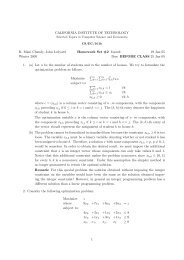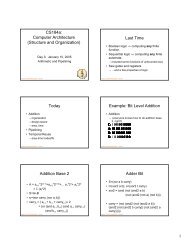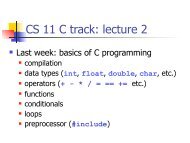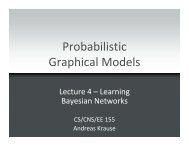Homework 1 Solutions - Caltech
Homework 1 Solutions - Caltech
Homework 1 Solutions - Caltech
You also want an ePaper? Increase the reach of your titles
YUMPU automatically turns print PDFs into web optimized ePapers that Google loves.
CALIFORNIA INSTITUTE OF TECHNOLOGYSelected Topics in Computer Science and EconomicsCS/EC/101bK. Mani Chandy, John Ledyard <strong>Homework</strong> Set #1 <strong>Solutions</strong> Issued: 7 Jan 05Winter 2005 Due: 17 Jan 051.2. (a) Let x ∈ H and y ∈ H be two generic tuples in H. The objective is to prove that for anya ≤ 1, we have that z = a · x + (1 − a) · y is a tuple in H. By definition of H this is trueiff g(z) ≤ d. Due to that g is convex by hypothesis, we have thatSince a ≤ 1 theng(z) = g(a · x + (1 − a) · y) ≤ a · g(x) + (1 − a) · g(y) (1)a · g(x) + (1 − a) · g(y) ≤ max{g(x), g(y)} ≤ d (2)Combining 1 and 2 we can conclude that g(z) ≤ d. This ends the proof.(b) Suppose by contradiction that H is not closed. Then there exists y ∈ dom(g) such thatg(y) > d and a sequence of tuples x 1 , x 2 , . . . , x n such that• x i ∈ H• lim i→∞ x i = ySince the function g is convex by hypothesis, then g is also continuous in all domain.Recollect the continuous function theorem for sequences stating: If a n is a sequence ofreal numbers, and if lim n→∞ a n = L, then the lim n→∞ f(a n ) = f(L) if f is a functionthat is continuous at L and defined at all a n . It holds:lim g(x n) = g( lim x n) (3)n→∞ n→∞Since x i ∈ H then lim n→∞ g(x n ) ≤ d. However g(lim n→∞ x n ) = g(y) > d. Hence, acontradiction has been obtained and consequenly H must be closed.3. (a) We start showing that the following statement holds: If for all j we have g j (x) ≤ b j andg j (x) ≤ q j for some fixed x, then g j (x) ≤ a · b j + (1 − a) · q j for any a ≤ 1. Let x = x 0a tuple which verifies the hypothesis of the statement. Due to the previous exercise weknow that H j = {x : g j (x) ≤ b j } is a convex set. Therefore we can find v, w ∈ H j suchthat x 0 = a · v + (1 − a) · w for some a < 1, v, w ∈ H j . Due to the assumption that g jis convex, we have thatg j (a · v + (1 − a) · w) ≤ a · g j (v) + (1 − a) · g j (w) (4)By hypothesis of the statement g j (v) ≤ b j and g j (w) ≤ q j , thus, we have thata · g j (v) + (1 − a) · g j (w) ≤ a · b j + (1 − a) · q j (5)
This ends the proof of the statement. It can now be easily concluded that for any a < 1and for any pair b, q of vectorsz(a · b + (1 − a) · q) ≥ max{z(b), z(q)} ≥ a · z(b) + (1 − a) · z(q) (6)The first part of inequality 6 follows because every feasible solution for z(b) and z(q) isalso a feasible solution for z(a · b + (1 − a) · q) due to the statement. Since a < 1 it iseasy to see that also the second part of the inequality holds.Hence, we have proven that z is a concave function.(b) z is in general nonlinear. In order to convince yourself, consider the function z(b), whereb = (b 1 , b 2 ) is two dimensional vector defined as:z(b) = max −x 2subject to: − x ≤ b 1 , x ≤ b 2Notice that −x 2 is a concave function and the two constraints in the problem are linear(therefore convex).Let b = (−2, 3) and q = (−3, 4). We then have that z(b) = −4 and z(q) = −9. We alsohave that z(b + q) = 25, where b + q = (−5, 7). Therefore z(b + q) ≠ z(b) + z(q) whichmeans that z is nonlinear.(c) The function z is monotonic non decreasing, i.e. if b ≥ q, then z(b) ≥ z(q). If the vectorx maximizes f when the vector of constraints is q (i.e. g j (x) ≤ q j ), then the same vectorx will be a feasible solution for the maximization problem when the vector of constraintsis b (in fact g j (x) ≤ q j ≤ b j ). Hence, z(b) ≥ z(q).2
















